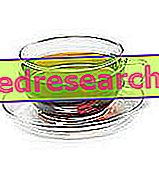Generality
Lovastatin is an active ingredient used in the treatment of hypercholesterolemia .

Belonging to the statin group, lovastatin can also be used to decrease excessively high levels of triglycerides in the blood and not just cholesterol levels.
In order to carry out its activity, lovastatin must be taken orally . Medicines based on this active ingredient can only be dispensed upon presentation of a repeatable medical prescription (RR); however, they are classified as band A drugs, therefore, when possible (presence of exemption for pathology ), their dispensation can be carried out by the National Health System.
Examples of Medicinal Specialties containing Lovastatin
- Lovinacor®
- Rextat®
- Tavacor®
Therapeutic indications
When is the use of Lovastatin indicated?
The use of lovastatin is indicated in the following cases:
- Treatment of primary hypercholesterolemia - including familial hypercholesterolemia - and of mixed hyperlipidemia when lifestyle improvements (diet, physical activity, body weight reduction) have not produced the expected results.
- Reduction of hypercholesterolemia in patients at high risk of cardiovascular diseases in which the diet has not led to satisfactory results.
- Reduction of hypercholesterolemia and the risk of myocardial infarction in patients with ischemic heart disease in whom the diet has not led to satisfactory results.
Warnings
Warnings and Precautions for the use of Lovastatin
Before starting lovastatin treatment, you must tell your doctor if:
- You suffer from interstitial lung disease;
- There are alterations in fat metabolism;
- You are suffering from disorders and diseases of the liver of any kind (the doctor will prescribe performing blood tests in order to regularly monitor liver activity);
- High amounts of alcohol are taken regularly;
- You are suffering from diabetes.
However, as a precautionary measure, before taking lovastatin-based medicines, it is always advisable to inform your doctor of your health conditions and the possible presence of any type of disorder or illness, even if not expressly reported in the aforementioned list.
Since lovastatin could cause myopathies, it is important to inform your doctor immediately if you experience the following symptoms:
- Muscle pain, also induced by palpation;
- Weakness;
- Fatigue;
- Soreness;
- Temperature;
- Dark urine;
- Elevation of creatine kinase levels.
In this regard, it is recalled that the risk of developing muscular disorders during lovastatin therapy may increase in the presence of:
- Serious kidney disease;
- Diabetes;
- Thyroid disorders;
- Alteration of mineral salt levels;
- Viral infections;
- Metabolic acidosis;
- Hypoxia;
- Hypothermia;
- Taking drugs or other substances of abuse.
Did you know that ...
An increased risk of developing muscle problems has also been reported in the event of intake of grapefruit juice and chamomile during treatment with the active ingredient described in this article.
Furthermore, if during treatment with lovastatin there is a need to undergo any type of surgery (including tooth extractions), it is necessary to immediately inform the doctor.
Please note
The use of lovastatin is not indicated in children and adolescents under 18 years of age.
Interactions
Interactions between Lovastatin and other drugs
The use of drugs that can increase the risk of muscular disorders when taken concurrently with lovastatin should be avoided. Among these, we find:
- Other lipid-lowering drugs (such as fibrates);
- Antibiotic drugs (such as macrolides, ketolides, fluoroquinolones and fusidic acid);
- Antihypertensive drugs;
- Immunosuppressive drugs such as cyclosporine;
- Drugs used in the treatment of stomach acid (for example, omeprazole, cimetidine, etc.);
- Antifungal drugs (eg, azole antifungals);
- Antiviral drugs;
- Antidepressants and anxiolytics;
- Anti-asthmatic drugs;
- Anti-gout drugs;
- Cumarinic anticoagulants;
- Verapamil;
- Amiodarone;
- Danazol;
- Quinine (antimalarial).
In any case, before using any type of lovastatin medicine, it is a good idea to tell your doctor if you are taking - or have recently been taken - drugs or products of any kind, including non-prescription medicines ( SOP), other over-the-counter drugs (OTC), herbal and phytotherapeutic products and homeopathic products.
Lovastatina with Food and Drinks
During treatment with lovastatin it is necessary to avoid alcohol, grapefruit juice and chamomile . Otherwise, there is a high risk of developing muscle disorders .
Side effects
Side effects caused by the assumption of Lovastatin
Despite the risk of developing serious muscular disorders (especially if you are in the presence of predisposing conditions) in most cases, lovastatin is well tolerated and causes generally mild and transient side effects. Among the most common, we remember:
- Weakness and muscle pain;
- Nausea;
- Abdominal pain;
- Dyspepsia;
- Constipation or diarrhea;
- Flatulence;
- Headache.
Among the less common side effects but which could still occur, however, we recall:
- Fatigue;
- Dizziness;
- Changes in vision;
- Alterations in the sense of taste;
- paresthesia;
- Insomnia;
- Chest pain;
- Muscle cramps;
- arthralgia;
- Heartburn and gastroesophageal reflux;
- Dry mouth;
- He retched;
- Skin rash;
- Itch;
- Alopecia;
- Eye irritations.
Furthermore, the possible onset of allergic reactions in sensitive individuals should not be forgotten.
However, it should be pointed out that not all patients experience the aforementioned side effects and, if they do, they may vary from individual to individual. In fact, each person reacts subjectively to the administration of the drug manifesting side effects that are different in type and intensity, or not manifesting them at all.
Finally, it should be remembered that the possibility of occurrence of side effects not present in the above list, but reported during treatment with other active ingredients belonging to the statin group, cannot be excluded. These side effects will not be mentioned in this article. For more information, see the information leaflet of the medicinal product based on lovastatin that must be used.
Overdose
The cases of lovastatin overdose are generally rare. However, if you take excessive doses of the active ingredient, you should contact your doctor immediately or contact your nearest emergency department.
There is no specific antidote, therefore, any treatment will only be symptomatic and supportive .
Action mechanism
How does Lovastatin work?
Like the other active ingredients belonging to the group of statins, lovastatin performs its cholesterol-lowering action through the inhibition of the enzyme 3-hydroxy-3-metiglutaryl coenzyme A reductase (HMG-CoA reductase). This enzyme is responsible for the conversion of 3-hydroxy-3-methylglutaryl coenzyme A into mevalonate, a fundamental precursor in the biosynthesis of sterols, including cholesterol.
Furthermore, this active ingredient is able to:
- Encourage the increase in the number of LDL receptors on the cell surface, consequently leading to an increase in LDL uptake and catabolism.
- Reduce plasma triglyceride levels.
Method of use and Posology
How to take Lovastatin
Lovastatin is available as tablets to be swallowed whole with the help of a little water. The tablets should NOT be taken on an empty stomach, but during dinner . If the doctor has prescribed two doses a day, the drug should be taken in the morning and in the evening, always on a full stomach .
The exact dosage (dose and time of intake) of lovastatin must be established by the doctor for each patient. However, the doses usually used in therapy are as follows:
- Treatment of hypercholesterolemia : the usual starting dose is 10 mg of lovastatin per day, to be taken in the evening during a meal. Afterwards, the amount of active ingredient to be taken can be increased by the doctor up to a maximum of 40 mg a day.
- Treatment of hypercholesterolemia in the presence of ischemic heart disease : the usual starting dose used is 20 mg lovastatin per day, to be taken in the evening during the meal. Thereafter, the dosage can be increased by the doctor up to a maximum of 80 mg per day.
In the presence of particular pathologies or in the case of concomitant intake of other drugs, the doctor may decide to decrease the dose of the active ingredient administered.
Please note
Before starting treatment with lovastatin it is necessary to adopt a diet low in cholesterol which must then be maintained even during treatment with the active ingredient in question.
Pregnancy and breastfeeding
Can Lovastatin be taken during pregnancy and during breastfeeding?
The use of lovastatin during pregnancy is contraindicated .
Women of child- bearing age should undergo a pregnancy test before starting any lovastatin treatments and, once they have begun, should take adequate contraceptive measures .
It is not known whether lovastatin is excreted or not in breast milk. However, as a precautionary measure, in order not to expose the newborn to risk of toxicity, the use of the active ingredient in breastfeeding mothers is contraindicated . If lovastatin therapy is unavoidable, then it is necessary to stop breastfeeding.
Contraindications
When Lovastatin should not be used
Lovastatin should not be used in the following cases:
- Known hypersensitivity to lovastatin itself and / or to one or more of the excipients contained in the medicinal product to be used;
- Known hypersensitivity to other active ingredients belonging to the statin group;
- In patients with liver problems of any kind (including elevation of transaminases);
- In patients with cholestasis;
- In patients with myopathies;
- In pregnancy and during breastfeeding.



